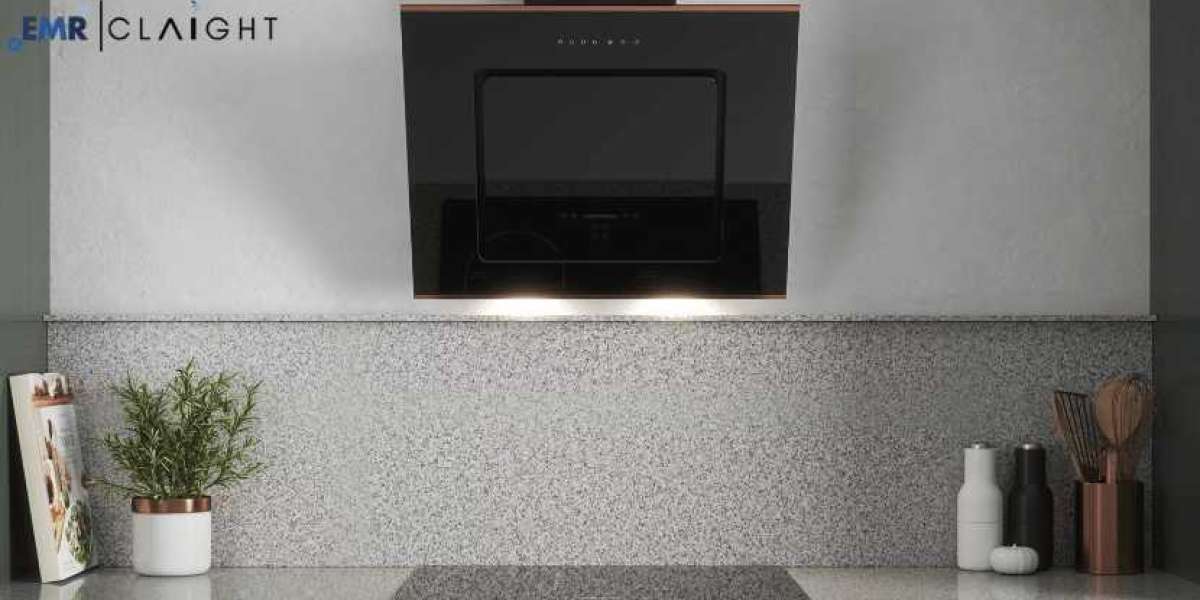Cooking Hood Market Outlook
The global cooking hood market, a vital segment within the home appliance industry, reached a significant milestone in 2023, with its market size valued at approximately USD 14.29 billion. This market, driven by the growing emphasis on kitchen hygiene, convenience, and the need for better air quality in homes, is expected to witness substantial growth in the coming years. Forecasts indicate that the market will expand at a compound annual growth rate (CAGR) of 5.0% from 2024 to 2032, reaching an estimated value of USD 22.21 billion by 2032.
Key Market Drivers
The cooking hood market is propelled by several factors that contribute to its consistent growth. These include rising urbanization, growing consumer awareness regarding indoor air quality, and technological advancements in kitchen appliances. Below are some of the most prominent market drivers:
Rising Urbanization and Changing Lifestyles: With the global population increasingly moving towards urban areas, the demand for modern kitchen appliances such as cooking hoods is on the rise. Cooking hoods are no longer considered a luxury but a necessity for maintaining hygiene and air quality in modern homes, especially in urban settings where space is limited, and kitchens are often smaller and more integrated into living areas.
Health and Environmental Awareness: As consumers become more aware of the harmful effects of cooking emissions such as smoke, grease, and airborne pollutants, the demand for efficient ventilation solutions has surged. Cooking hoods help mitigate these risks by filtering out unwanted fumes and improving indoor air quality.
Technological Advancements: Manufacturers are continuously innovating and enhancing their product offerings by integrating advanced technologies such as energy-efficient motors, smart sensors, and IoT-enabled features into cooking hoods. These advancements not only make cooking hoods more efficient but also cater to the modern consumer's demand for smart home solutions.
Aesthetic Appeal and Customization: Today’s consumers not only seek functionality but also value the aesthetic appeal of kitchen appliances. Cooking hoods are available in various designs and finishes to match the decor of contemporary kitchens. The growing demand for premium, customizable kitchen appliances is also pushing market growth.
Get a Free Sample Report with Table of Contents@ https://www.expertmarketresearch.com/reports/cooking-hood-market/requestsample
Market Segmentation
The global cooking hood market can be segmented based on product type, application, distribution channel, and region.
1. By Product Type:
- Wall-Mounted Hoods: Wall-mounted cooking hoods are the most common type, typically installed against the kitchen wall above the stove or cooktop. Their wide range of designs, from sleek modern models to more traditional ones, makes them a popular choice.
- Ceiling-Mounted Hoods (Island Hoods): Ceiling-mounted hoods, often referred to as island hoods, are installed directly above kitchen islands. These hoods are designed to provide ventilation in open-plan kitchens where the cooking area is located in the center of the room.
- Under-Cabinet Hoods: These hoods are mounted underneath kitchen cabinets, making them ideal for kitchens with limited space. Their compact design is especially suitable for smaller apartments or homes.
- Downdraft Hoods: Downdraft hoods are integrated into the countertop and are less visible, making them a sleek option for minimalist kitchen designs. These hoods rise from the counter when in use and retract when not needed, offering a modern solution for kitchen ventilation.
2. By Application:
- Residential: The residential segment holds a significant share of the market due to the increasing construction of modern homes and apartments that require efficient kitchen ventilation systems.
- Commercial: Commercial kitchens, such as those in restaurants, hotels, and catering businesses, also represent a key market for cooking hoods. These environments require heavy-duty ventilation systems to handle the large amounts of smoke, steam, and grease generated during extensive cooking operations.
3. By Distribution Channel:
- Online: The online segment is rapidly growing due to the increasing popularity of e-commerce platforms that offer a wide range of cooking hood models. Consumers appreciate the convenience of online shopping, detailed product descriptions, and reviews.
- Offline: Traditional brick-and-mortar stores still account for a large share of the market, as many consumers prefer to view and evaluate appliances in person before making a purchase. Home improvement stores, specialty kitchen appliance retailers, and department stores are key offline distribution channels.
Regional Analysis
The global cooking hood market is geographically segmented into North America, Europe, Asia-Pacific, Latin America, and the Middle East Africa. Each region has its own distinct trends and market drivers.
1. North America:
North America holds a significant share of the global cooking hood market, driven by the high adoption of modern kitchen appliances and the growing awareness of air quality standards. The U.S. and Canada are key markets in this region, with consumers demanding energy-efficient and aesthetically appealing kitchen appliances. Technological innovations and the growing trend of smart homes are also contributing to market growth in this region.
2. Europe:
Europe is another prominent market for cooking hoods, with countries such as Germany, France, and the United Kingdom leading in terms of sales. The region’s well-established construction and renovation industries, coupled with a strong focus on energy efficiency and sustainability, are driving the demand for advanced cooking hood solutions. The European market is also characterized by a preference for high-end, designer kitchen appliances, with a growing demand for premium brands.
3. Asia-Pacific:
The Asia-Pacific region is expected to witness the highest growth during the forecast period, owing to the rapid urbanization and increasing disposable incomes in countries like China, India, and Japan. The expanding middle-class population in these countries is driving the demand for modern kitchen appliances, including cooking hoods. Additionally, the rise in residential construction projects and the growing number of commercial kitchens are contributing to the market's expansion in this region.
4. Latin America:
Latin America is emerging as a potential market for cooking hoods, with Brazil and Mexico leading the region. Increasing urbanization, coupled with the rise in homeownership, is creating demand for modern kitchen appliances in this region. The market is also benefiting from the growing trend of kitchen remodeling and renovation.
5. Middle East Africa:
The Middle East Africa region is expected to witness moderate growth in the cooking hood market. The region’s booming real estate and hospitality industries, particularly in the UAE and Saudi Arabia, are driving the demand for advanced kitchen ventilation solutions. Moreover, the growing emphasis on indoor air quality in urban areas is expected to fuel market growth.
Competitive Landscape
The global cooking hood market is highly competitive, with several key players striving to expand their market presence through innovation and strategic partnerships. These companies are focusing on product differentiation, technological advancements, and eco-friendly solutions to gain a competitive edge. Some of the major players in the market include:
- AB Electrolux
- Whirlpool Corporation
- Haier Group
- Broan-NuTone LLC
- Hangzhou Robam Appliances Co.,Ltd.
- Elica S.p.A.
- Groupe SEB
- LG Corporation
- General Electric Company
- BSH Home Appliances Group
- Miele Incorporated
- Others
Future Trends and Opportunities
The cooking hood market is poised for growth, with several trends and opportunities expected to shape the industry in the coming years.
1. Smart Kitchen Appliances:
The integration of smart technologies into cooking hoods is one of the most promising trends in the market. IoT-enabled cooking hoods that can be controlled remotely via smartphone apps are gaining popularity among tech-savvy consumers. These smart appliances offer features such as automatic ventilation based on air quality sensors, voice control, and energy efficiency monitoring.
2. Energy Efficiency:
With increasing global concerns about energy consumption and environmental sustainability, manufacturers are focusing on developing energy-efficient cooking hoods. Energy Star-certified appliances and hoods with low noise levels are becoming more prevalent as consumers seek eco-friendly solutions for their homes.
3. Growing Demand for Aesthetic and Customizable Solutions:
Modern consumers are looking for kitchen appliances that not only perform well but also enhance the overall aesthetics of their kitchens. The growing trend of open-plan kitchens has led to an increase in demand for sleek, customizable cooking hoods that blend seamlessly with the kitchen decor. Manufacturers are offering a range of finishes, colors, and materials to cater to this demand.
4. Focus on Indoor Air Quality:
As awareness about indoor air pollution rises, consumers are increasingly prioritizing air quality in their homes. Cooking hoods with advanced filtration systems, such as charcoal filters and recirculating fans, are becoming popular as they effectively remove harmful particles from the air. This trend is expected to drive further innovation in the design and functionality of cooking hoods.
5. Sustainability and Eco-Friendly Materials:
The shift towards sustainability is prompting manufacturers to use eco-friendly materials in their products. Cooking hoods made from recyclable materials and those that consume less energy are likely to gain traction in the coming years as consumers become more environmentally conscious.
Media Contact:
Company Name: Claight Corporation
Contact Person: Eren smith, Corporate Sales Specialist – U.S.A.
Email: sales@expertmarketresearch.com
Toll Free Number: +1-415-325-5166 | +44-702-402-5790
Address: 30 North Gould Street, Sheridan, WY 82801, USA
Website: https://www.expertmarketresearch.com
Aus. Site: https://www.expertmarketresearch.com.au














